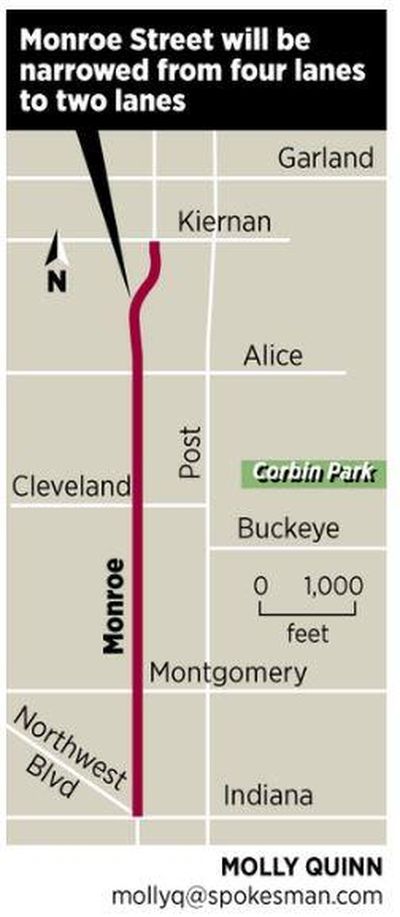North Monroe business people rally against planned ‘road diet’ for the arterial

Business owners and neighbors rallied on Tuesday morning along North Monroe against a plan to redesign the busy road from five lanes to three.
The plan, often called a “road diet,” is touted as making a road more useful to pedestrians and bikes, and slowing traffic, which boosts safety.
Nearly 50 people gathered at Skippers Restaurant, 3320 N. Monroe St., where owner Gary Jarvis is leading the opposition. They said they would post signs in their shops and reach out to customers to help build opposition to the planned changes on North Monroe.
The $7 million North Monroe plan would convert a section of the street north of Indiana Avenue from four lanes with a center turn lane to two lanes with a center turn lane. That would allow for wider sidewalks and roomier parking, city officials have said. In addition, the city plans to install new landscaping and pedestrian lighting.
Spokane Transit Authority buses would remain in the travel lanes, which would force traffic to wait behind buses at stops, but the number of stops would be reduced from four to three.
“It’s ill conceived,” Jarvis said of the “road diet” plan. “It’s not going to bring business to the area … It’s just a yuppie thing.”
The idea arose from a neighborhood planning process in recent years and won grant funding for its safety benefits, neighborhood leaders said.
Jarvis noted during the rally, “We are for safety.”
The crowd assembled inside Skippers and then they moved outside and crossed Monroe in 14-degree weather so they could take a group photo beneath a billboard declaring the opposition. They held signs that read, “Say No to Monroe Street Project.”
Radio ads against the project have also been started, Jarvis said.
In the hours after the rally, Jarvis said he heard from more community members who are opposed to the project.
“We are getting all kinds of people stopping by, lots of calls,” he said.
The group has a series of concerns, including slower travel times and reduced traffic on Monroe. In addition, a major road project would cause inconvenience and make it difficult for customers to reach businesses during the work.
But opinions about the project in the neighborhood and among businesses is far from one-sided.
“Monroe is tipped much too far toward transient vehicle traffic,” said E.J. Iannelli, a neighborhood council member. He said opponents are stuck on the idea that fewer lanes equals less traffic equals less business.
Most of the vehicles traveling through the corridor are rushing by and not stopping as it is, Iannelli said.
A more pedestrian-friendly environment would encourage a sense of community and draw people to stop and shop, he said.
Megan Kennedy, who owns Rogue Heart Media with her husband, Rob, said she is trying to revive a North Monroe Business District group that supports the change.
She’s trying to downplay the conflict so that different interests can ultimately work together in the future, she said.
Opponents of the project said City Hall has not been listening. “The community has not had its voice heard,” Jarvis said.
Marlene Feist, director of strategic development for the city utilities department, said that City Hall wants to hear the concerns from businesses. The city formed a North Monroe Corridor Advisory Board with business owners and residents.
Work would begin in 2018, and there is no indication from city elected leaders to shelve the project, Feist said.
The street averages 16,000 vehicles a day, Feist said, but opponents challenged that number as too small.
Utility work, including stormwater facilities, would be part of the job.